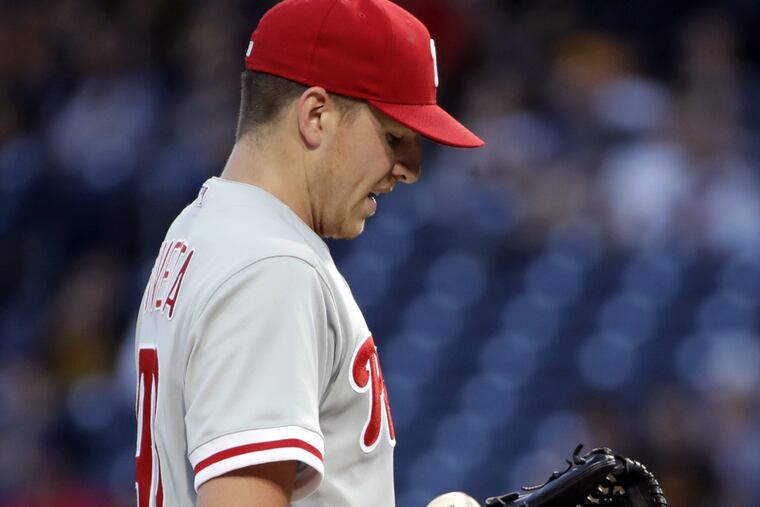When and how the Phillies once played nine innings in 51 minutes
The opener to a meaningless, season-ending doubleheader was 3 hours and 39 minutes quicker than the Phils-Pirates marathon Friday night.

Not much is absolute about that Sunday afternoon in New York. No one knows if the Phillies and Giants conspired to set a baseball record that nearly a century later still exists. No one is sure if the batters displayed unusual impatience, if the players showed extra hustle in exiting and entering the field, if the pitchers worked even faster than normal.
In fact, all that's really certain about the Giants' 6-1 Polo Grounds victory over the Phillies on Sept. 28, 1919, is that a game like that will never happen again.
The opener to a meaningless, season-ending doubleheader lasted just 51 minutes. The fastest nine-inning game ever, it was 3 hours and 39 minutes quicker than the Phils-Pirates marathon last Friday night that tied a mark for the longest nine-inning game in National League history.
On the surface, what's surprising about the 1919 speedathon is that it wasn't a pitchers' duel. The two teams combined for 18 hits, 3 walks, 7 runs. Given 2018 sensibilities, it's virtually impossible to imagine how all that could have transpired in less than an hour without the aid of complicit players.
The game, even by 1919 standards, was so unusually rapid that it warranted headlines the next day. "Less Than An Hour To Beat Phillies" was the Inquirer's, "Giants Beat Time Record As Season Closes," read the New York Daily News'. But only one contemporary newspaper account provided an explanation.
According to the New York Daily News, a newspaper that had debuted just three months earlier, "the Giants and Phillies agreed to go after the speed record before the game started." The fastest game until then, according to the paper, had been a 56-minute Giants-Brooklyn contest in 1918.
Unfortunately, that correspondent provided no evidence. And the Inquirer and New York Times stories seemed to contradict that theory. Both noted that, until Phils shortstop Dave Bancroft swung at a bad first pitch with two outs in the ninth, nothing fishy was apparent.
There was "no unusual effort to make a speed record until the Phillies half of the ninth," the Times correspondent wrote.
While we'll probably never know exactly what happened, for any teams interested in playing the fastest game ever, Sept. 19, 1919, was as good as any day to try.
For one thing, it was a Sunday getaway game, a spot when visiting teams traditionally are far less patient at the plate. Also, the season ended that day for both the last-place Phils and second-place Giants. And finally, 1919 was a particularly ripe time for baseball conspiracies. The 1910s, according to most baseball historians, was rife with gambling. The infamous Black Sox World Series was just three days away.
Regardless, the Phillies' 89th and penultimate loss that season was one for the record books.
Philadelphia starter Lee "Specs" Meadows, the first modern-era big-leaguer to regularly wear glasses, walked three, struck out one and allowed 13 hits — three to the spectacularly nicknamed George "High Pockets" Kelly — to finish his season 12-20. New York's Jesse Barnes, meanwhile, permitted five hits, no walks and struck out two in recording his NL-best 25th victory. The Giants stranded seven baserunners, Philadelphia six.
With all that activity, the game itself must have been played at a blinding speed. Even in an era when there were no electronic-media delays and when the average game was more than an hour faster than today's (1:47 in 1920 compared to 3:05 in 2017), 51 minutes was a breathtaking pace.
Yet both the Inquirer and Times pointed out that everything appeared normal on the field until Bancroft's game-ending at-bat. In grounding out, the Inquirer noted, the future Hall of Famer made "a feeble effort to put a ball in play."
If the speed-up had been intentional and obvious, it's unlikely the home-plate umpire, the legendarily stern Bill Klem, would have allowed it.
Curiously, if those two teams did intend to play as fast as possible, they had some practice at it. In September of 1913, the Phillies and Giants completed an exhibition game in just 32 minutes. But in that one, hitters ran out balls in play until they either scored or were put out, and fielders sprinted on and off the field.
The Phillies would end the woeful 1919 season with a 7-1 Game 2 loss to New York's Bill Hubbell. If, in fact, they'd been in a hurry to start their offseason in Game 1, you'd expect Game 2 to have been even quicker.
We'll never know.
While we can assume it was slower than the history-making opener, no one bothered to note the time of game in either the box score or any newspaper account.